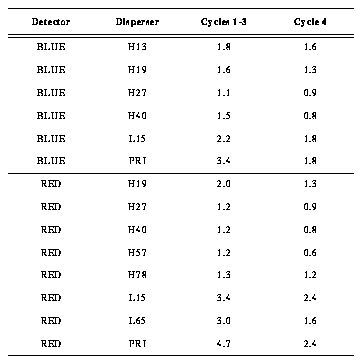
Percent rms Scatter in the Sensitivity Curves Averaged Over All Wavelengths for Each Mode

In a few cases, large photometric errors (greater than 3 s) are found in the observations. Table 5 gives a list of the observations of the standard photometric sources that were deleted from our analyses of repeatability.
Observations Deleted from this Analysis

The three red side observations with the Y-base problem represent 2.4% of all of the red side standard star observations and are all low by 2-4% in flux. On the red side, the proper Y-base for an FOS observation is difficult to determine precisely because of a one sigma scatter of ~0.1" in the measurements and a systematic change with time (Koratkar, Keyes, & Holfeltz 1995). Red side Y-base errors greater than 0.2" can be expected for ~10% of red side observations. However, the three red side observations with low flux must have had a total Y-base error of ~0.4-0.5" and imply an unfortunate loss of flux in a few percent of FOS observations when non-optimal commanded Y-base values, GIMP, and filter grating wheel errors combine at their maximum positional uncertainty range. For typical GO observations, larger acquisition errors of ~0.2" combine with non-optimal Y-base positioning of the spectrum on the diode array to cause more frequent photometric problems.
The entire set of red side observations of HZ44 are low in flux by 5-10% and have not been included in the calibration data for FOS. An examination of the target acquisition data suggests that the initial pointing error exceeded 2" and prevented the peakup sequence from converging exactly. Zero proper motion was entered, while Luyton and Miller (1951) give -0.052 and +0.035 arcsec/yr on the sky for the proper motion in right ascension and declination, respectively. Since HZ44 may be at a distance of 1-2 kpc, this value of proper motion might be treated as an upper limit. However, in the 11 years since the 1984 epoch of the Guide Star plate, HZ44 may have moved a significantly large 0.7". The actual direction of the initial FOS pointing error and the earlier epoch Palomar plate positions should be checked to independently estimate proper motion for HZ44.
Generated with CERN WebMaker